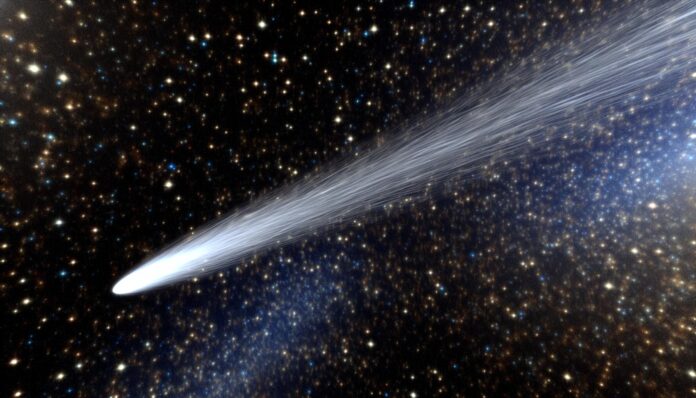Unlocking the Secrets of Comet 3I/ATLAS
In July 2025, astronomers announced a discovery that has electrified the scientific community: the third confirmed interstellar object to visit our solar system, comet 3I/ATLAS, has had its origin traced to a distinct region outside our own cosmic backyard. This achievement marks a groundbreaking first, unlocking new opportunities for understanding the vast and varied environments beyond our solar system.
Most importantly, this discovery opens up fresh avenues for research in both astrophysics and planetary science. Because it provides a direct link to conditions and formations that occurred in distant parts of our galaxy, 3I/ATLAS is not merely a passing visitor, but a treasure trove of cosmic history waiting to be unraveled.
The Discovery: How Did We Find 3I/ATLAS?
Comet 3I/ATLAS was initially detected on July 1, 2025, by the ATLAS telescope in Río Hurtado, Chile. Its unusual and unexpected hyperbolic trajectory immediately set it apart from typical solar system bodies. Most importantly, early calculations clearly indicated that its speed and path were inconsistent with any object gravitationally bound to our Sun, suggesting an origin from elsewhere in the galaxy.
Advanced observations and rapid follow-up studies confirmed the object’s interstellar nature. Therefore, scientists quickly embraced the significance of its detection, recognizing that the comet represents only the third interstellar visitor ever recorded. Additionally, detailed tracking and computational modeling — similar to discussions showcased on the NASA JPL overview on YouTube — have solidified our understanding of its unprecedented orbit.
What Makes a Comet ‘Interstellar’?
Determining an object’s interstellar origin revolves around analyzing its orbital eccentricity and velocity. Most solar system objects, such as periodic comets, usually have eccentricities significantly below 1. In contrast, comet 3I/ATLAS exhibits an eccentricity estimated around six, a value that far exceeds that of any solar-bound body. This hyperbolic path serves as a cosmic fingerprint, indicating that the comet is merely passing through our system rather than orbiting the Sun permanently.
Besides that, its extraordinarily high relative speed of about 60 km/s further confirms that it is not held by the Sun’s gravitational pull. Because this unusual velocity is incompatible with typical orbital dynamics, scientists are now provided with a distinct case study to explore interstellar material and its behavior outside the confines of our solar system. This also reinforces findings shared in articles by ESA and CBC, which highlight the comet’s intriguing characteristics.
Tracing the Comet’s Origin: A Scientific First
Perhaps the most exhilarating aspect of this discovery is the successful effort to trace 3I/ATLAS’s origin back to a specific region within the Milky Way. By employing advanced modeling and robust astronomical data, researchers have achieved what was once thought to be impossible. Most importantly, this meticulous tracing not only confirms the comet’s interstellar credentials but also sets a new benchmark for galactic cartography and dynamical studies.
Furthermore, this breakthrough methodology gives scientists an unprecedented opportunity to test theories of galactic dynamics. Because it accurately identifies how objects are ejected from their original stellar systems, it adds invaluable data to our understanding of cosmic evolution. Besides that, it also validates the results published by IFLScience, offering further insight into the complex journey of interstellar wanderers.
Why 3I/ATLAS Matters
Studying interstellar comets like 3I/ATLAS provides scientists with an extraordinary window into the composition of planetary systems beyond our own. Because these objects carry ancient chemical signatures and physical structures formed billions of years ago, they serve as natural time capsules from distant regions of the galaxy. Most importantly, investigating their makeup will undoubtedly refine our current understanding of star and planet formation processes.
Moreover, the successful tracing of 3I/ATLAS’s origin illustrates the power of modern astronomical surveys and high-precision computational modeling. Therefore, every observation made of this comet enriches our knowledge, paving the way for future discoveries and more sophisticated models of interstellar dynamics. Besides that, the ongoing study of such interstellar objects also encourages global collaboration between research institutes, as showcased on platforms like ESA and CBC.
What’s Next for 3I/ATLAS?
Currently, comet 3I/ATLAS is on its journey, making its closest approach to the Sun in late October 2025. It is predicted to pass just inside the orbit of Mars, presenting an invaluable but narrow window for researchers to gather critical data. Because interstellar objects are extraordinarily rare, every observation is meticulously planned and cherished, ensuring that every detail of its physical and chemical properties is recorded.
The scientific community, therefore, is racing against time to capture high-resolution measurements of its tail, nucleus, and other features. Most importantly, these studies will inform our future detection efforts, as explained in the ESA report. Because the comet is a bearer of ancient cosmic information, its continued monitoring is critical for advancing our understanding of the galaxy and the origins of interstellar objects.
Conclusion: A New Era of Interstellar Discovery
The successful identification and tracing of comet 3I/ATLAS marks a milestone in the field of astronomy. It underscores the significance of international cooperation, cutting-edge detection systems, and sophisticated simulation techniques. Most importantly, this achievement reaffirms that our solar system is only a small part of a vast and dynamic cosmic tapestry, constantly connected to celestial phenomena occurring light-years away.
Because the voyage of 3I/ATLAS is a vivid reminder of the endless wonders lurking in deep space, astronomers are more motivated than ever to scan the skies for similar visitors. Therefore, as new technologies emerge and sky surveys become even more sensitive, we can expect a surge in discoveries that will further unravel the mysteries of the universe. Besides that, this historic tracking effort heralds a future where interstellar encounters will not only be observed but also thoroughly understood, enriching our comprehension of the cosmos for generations to come.
- ESA: 3I/ATLAS Discovery
- CBC: 3I/ATLAS Eccentricity
- IFLScience: Tracking 3I/ATLAS
- NASA JPL: 3I/ATLAS Overview



